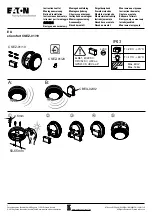
J500-41-00
7
I56-2199-003R
[9.2.2] Alarm Tests
[9.2.2.1] M02-04-00 Magnet Test
1. Place the painted surface of the magnet onto the TEST locator on the
bottom of the detector housing (Figure 14).
2. Verify system control panel alarm status and control panel execution
of all intended auxiliary functions (i.e. fan shutdown, damper control,
etc.)
3. The detector is self-restoring when the magnet is removed. Verify that
the system control panel has reset; the panel may have to be reset.
[9.2.2.2] RTS451/RTS451KEY Remote Station Test
The RTS451/RTS451KEY Remote Test Station facilitates test of the
alarm capability of the duct smoke detector. These accessories provide
the stimulus to initiate an alarm condition at the detector. The detector is
self-restoring when the accessory test stimulus is removed. Verify that the
system control panel has reset; the panel may have to be reset.
[9.2.3] Sensitivity Tests
Notify the proper authorities that the smoke detector system is under-
going maintenance, and that the system will temporarily be out of ser-
vice. Disable the device or system undergoing maintenance to prevent
unwanted alarms and possible dispatch of the fire department.
[9.3] Maintenance of Duct Smoke Detectors
[9.3.1] Air Filters
1. Turn off power to the system.
2. Remove and inspect sampling tube filters.
3. If filters are heavily coated with dirt, replace them with new filters (p/n
F36-09-11). If they are not heavily coated, use a vacuum cleaner or
compressed air nozzle to remove dust, then reinstall the filters.
5 7
PA400
5 = Alarm Signal
7 = Aux. Power (–)
Figure 12. Detector with optional PA400
Figure 13. Insulator card for DH300RPL
H0132-00
H0133-00
H0130-00
Figure 14. Testing detector alarm:
Figure 10. Wiring Diagram for DH300RPL Duct Smoke
Detector with optional RA400Z
5 7
RA400Z
5 = Alarm Signal
7 = Aux. Power (–)
DO NOT BREAK TAB ON RA400Z
H0135-00
Figure 11. System Wiring Diagram
for DH300RPL Duct Smoke
Detector with RTS451/RTS451KEY
ALARM SIGNAL
AUX. POWER (–)
TEST +
TEST –
ALARM SIGNAL
NOT USED
NOT USED
CIRCUIT
REFERENCE
TEST
SWITCH
FOR RTS451, TERMINAL 3 IS NOT
USED. (RTS451 DOES NOT HAVE
A TERMINAL 6.) FOR RTS451KEY,
TERMINALS 3 AND 6 ARE NOT USED.
RTS 451/RTS451KEY
5
7
4
3
1
3
6
2
4
5


























